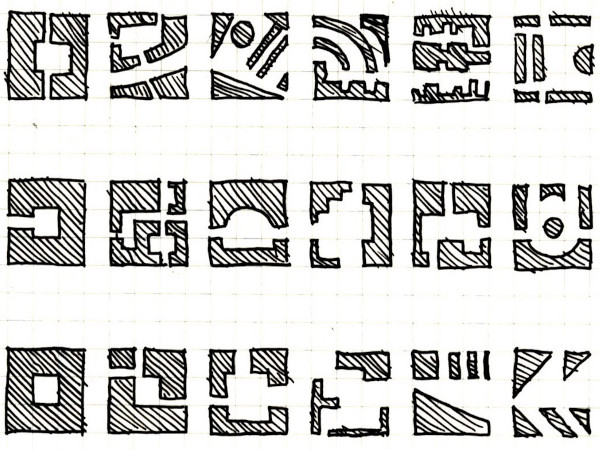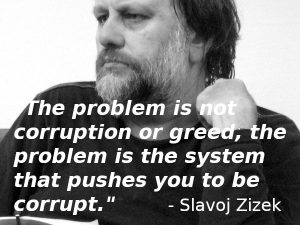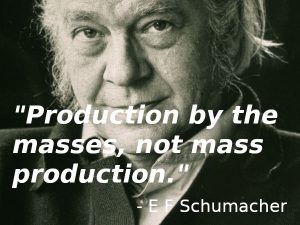Pattern language - introduction

“Master plans fail because they create totalitarian order, not organic order. They are too rigid; they cannot easily adapt to the natural and unpredictable changes that inevitably arise in the life of a community.” – Christopher Alexander
Contents
What is pattern language?
It’s a design tool for complex systems, with enough simplicity to allow people to solve small design problems, without losing the connection to the whole. We have to be able to deal with complexity without collapsing it into simplistic notions. Pattern language is an excellent tool for that. From a low-impact perspective, it’s a tool for designing a new economy.

Many people interested in creating a better world talk about holism – looking at things holistically / as a whole. They understand that with a complex system (like the global economy), looking at things in little boxes, reductively, won’t work – we have to look at the system as a whole. However, there are very few practical tools for working in this way. Our brains can’t manage a large range of variables at the same time, so we tend to look at things, and work, in reductive ways. Systems thinkers often produce extremely complicated diagrams, that aren’t helpful for most people, who can find them intimidating.
Complex systems like global ecology or the global economy require holistic, systems thinking if we are to interact with them safely. Complex problems are often called ‘wicked’ problems – and they’re hard. Most tools focus on one part of the problem, and ignore the rest. Disciplines like Permaculture, where practitioners really do design for complexity, without cutting things out, have taken decades to develop, and the community is still small. It’s not easy.

History
Christopher Alexander was a professor of architecture who came up with the pattern language idea in the 1960s. He’d been taking apart complex design problems, solving the simple constituent problems, and figuring out how to arrange the simple solutions as a ‘tree’. He used computers to do it – quite futuristic at the time. His reputation spread, yet he wasn’t driven by a desire for fame or money, but by a desire to make beautiful things. But this method he’d been using didn’t do it.
In 1965 he wrote an essay entitled A City is Not a Tree (here’s the pdf). A tree is a reductive way of mapping something that looks complicated, but actually, there are only a few parts of the map – trunk, branches, twigs and leaves. The branches can’t re-connect to anything once they’ve branched. He realised that this isn’t how real life works. Any component of a complex system performs several roles simultaneously. For example, a door is a way in and out, a boundary, a place to bring furniture and shopping in, welcome people to your home, say goodbye to them when they leave, or check who’s calling, it can make your house look pretty, allow letters to be delivered, stop intruders – and it does all those things even though it’s really just a piece of wood.
This was going against the grain, and against his previous way of working, but he persevered, developed his ideas, and wrote A Pattern Language in 1977, which focuses on architecture (still in its first edition, and still selling well).

What are the benefits of pattern language?
Design can happen in various ways: with a reductivist focus – like minimising costs and maximising profits, or on maximising the number of vehicles past a certain point in the shortest time possible; with a top-down, centrally-planned approach; or with an artistic approach, relying on creative people to come up with solutions. Often, it’s people using this creative approach who tweak things so that they get better, in an evolutionary way. Another approach is to let things grow organically from the grassroots – the way most towns were originally built. This grassroots approach has been suppressed by modernity and capitalism, even though medieval Italian towns (say) are among the most beautiful, walkable, sustainable and vibrant places to live, in ways that centrally-planned cities can never be. Pattern language can help recreate the grassroots, organic approach that has served us so well in the past, but now including things like good sanitation, internet etc.

It can help us design an economy without reductively focusing on single metrics like GDP growth. An understanding of the effects of perpetual GDP growth on global ecological systems can help us understand that we have to move away from a perpetually-growing economy. Rational design of components of a system, and understanding the effects on the system of those designs, is crucial at this point in our history, where more and more irrational design can destroy nature and really harm us. Pattern language can be used to look at everything from ‘what is a coin, a token, a voucher, a promise?’ etc. to emergent patterns such as ‘what is a regenerative economy that doesn’t destroy nature or concentrate wealth in very few hands?’.

Alexander’s book, A Pattern Language, doesn’t have to be read from front to back. It can be dipped into, and different sections link to others, like a wiki. In fact, wikis probably wouldn’t exist if not for Alexander. Ward Cunningham, inventor of the wiki concept, cited him as a major influence.
What can I do?
Read A Pattern Language (pdf).
Pattern language is optimally-designed for human systems that are necessarily complex. The economy is a good example, as is Alexander’s field – architecture – but it can also be used in education, software, human-computer interaction, governance and meetings / human-human interaction. Generally, pattern languages can be used wherever humans want to make things different in a complex environment.
If you work in any of these fields, and more, it’s a very interesting way of helping design components of your work in a holistic way. For us, pattern language is a tool for system change – change as in replacement, not reform. No component patterns of the new system are dominant or subservient – they’re all necessary in their own right.
If you read Alexander’s book (and/or the companion volume, The Timeless Way of Building, which provides a more emotional, philosophical way into the subject) you’ll gain an understanding of systems thinking, and how different elements of a system relate to each other – how patterns contribute to patterns of wider scope, and are made up of patterns of smaller scope. It can help people engage with complex systems (like the economy, for example) confidently. By using pattern language, you’ll be able to design better doors, buildings, gardens, smallholdings, software, products, energy systems, lessons, meetings, facilitation, governance, businesses, DAOs – anything.
A pattern isn’t easy to write, as Alexander admits in the intro to his book. It has to describe the wider patterns that it fits into, to make them more dynamic, sustainable etc., but it also has to describe the smaller patterns that comprise it, and hopefully make it better. Each pattern is knitted into the whole, encouraging you to look both up and down, and trace all the connections.

The trick is to look for a set of related patterns that you think will contribute to the scope of the work at hand. It’s not at all about top-down planning. Taking cities as an example, most planned cities are desperate failures (as outlined in Seeing Like a State, and in the work of Jane Jacobs). A mosaic / diversity pattern for a city will contain many smaller patterns that contribute to it. You may not be able to work at the level of the entire city – your role might be designing or creating a particular building, or even a component of a building – but by using a pattern language you’ll see how all the different patterns are connected and nested. Smaller patterns can be used to build components, then larger patterns will emerge. Good doors can be part of good buildings, that are part of good neighbourhoods, which comprise good cities, which comprise good societies. Nothing is unimportant in a complex system (cf. the Butterfly Effect).
A pattern is not a detailed plan. Using a door as an example, a pattern will describe the characteristics of a good doorway, not the precise dimensions.

Pattern language has fallen out of favour in the world of architecture, where our flawed economy has encouraged the ‘wow factor’ for maximum fame / profit, rather than buildings and neighbourhoods that are good for people. But it’s been used a lot in the worlds of tech / software and of governance / human interaction / collaboration. Group Works (a community of over 200 people) have used pattern language to ‘bring life to meetings and other gatherings’. The Wise Democracy Project is using pattern language to design better governance. Rob Hopkins, founder of the Transition movement, is inspired by Chris Alexander, and has talked about reframing Transition as a pattern language. If you’re interested in any of these areas (and more), you can join their communities and collaborate with them. You’ll find plenty of people in these areas that are happy to talk about patterns they’ve used in their work.
In the introduction to A Pattern Language, Alexander describes the poetry of the language, and warns that you won’t be able to write poetry from day one. It’s a journey, that can be difficult, but rewarding.
Specialist(s)
Thanks to Dil Green of the Pattern Language Institute for information.
The specialist(s) below will respond to queries on this topic. Please comment in the box at the bottom of the page.

Dil Green studied with Christopher Alexander, the inventor of pattern language, and subsequently used the approach in his architectural / building work. Later he realised that pattern language can be used to map complex systems in ways that make them easier to understand and to change them safely. He’s an advisor at Building Beauty – the school that Christopher Alexander founded.







